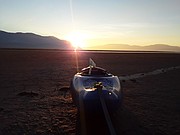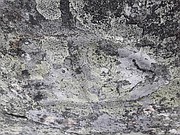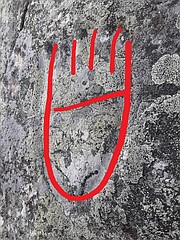A muddy trek into the past
I get the winter blues.
This is the time of year I daydream about spring adventures. I’ll search the internet for places I haven’t been, staring at Google Earth or researching obscure publications.
One such publication I stumbled across mentioned petroglyphs on the shore of a local lake. I probed deeper into the possibility of Indian rock art existing much closer than I had expected and found a publication written 50 years ago describing the petroglyphs.
Even better, there was an old black and white map that showed the location of the best of these petroglyphs. I was stunned. I knew exactly where they were.
The first snows of the year were expected any day, so I planned a hurried trip to locate them before winter closed in, making them impossible to find.
Google Earth revealed that I either had a long hike in to the petroglyphs, or a decent paddle across the lake from a spot where my family and I have spent many sunny days camping and playing in the water. I chose to paddle, so I threw my whitewater kayak and my drysuit into the truck and took off one Sunday morning.
As soon as the lake came into view, I knew my adventure was already rapidly adjusting from the vision of ease I had imagined, to the type of adventure I should know to expect.
The lake level was much lower than I had anticipated. The water between the petroglyphs and where I stood was mostly ice and milfoil instead of the easily paddled open water I had envisioned. Just to get to the water I had to hike across a half-mile of mud.
I threw my kayak on my shoulder and trudged on, my dry suit quickly becoming covered in mud up to my knees.
When I dropped the kayak at the edge of the ice, I stood and considered how I would get across this obstacle. I grabbed my paddle and started breaking apart the ice. Soon I was out in it, covered in milfoil, which clung to my paddle whenever I broke the ice in front of me enough that I could paddle forward.
I had milfoil splattered across my cheeks. It was useless to clean off. Another piece would be flung into my face with the next paddle stroke.
I reached a small patch of open water and again considered how best to get from where I floated in my kayak to the patch of rock 200 yards in front of me, guarded by another, longer, section of ice and milfoil. The alternative routes looked no less unpleasant, so I started once again stabbing at the ice.
Soon my paddle encountered the muddy bottom so I happily slid out of my kayak expecting an easy walk to shore, and sunk to my knees in the soft muck. Every time I sunk my leg into the muck a collection of bubbles burst at the surface, releasing the aroma of decomposing vegetation and duck feces.
By the time I reached the rocky shore I was exhausted. The approximately 1.5 miles from my truck to the rocky point had taken me almost an hour. I was covered in a jambalaya of mud and milfoil.
I searched for about 15 minutes before finding the petroglyphs in the most obvious place. The largest rock with the flattest face on the top of the small hill overlooking the water.
I placed my hand on the rock, next to the large bear paw carved into the rock face. In all, there were supposed to be 26 bear paws on this rock, but it was difficult to find most of them. In some places it appeared the rock face had been chipped off, perhaps by someone trying to decorate their living room with ancient Indian rock art.
The winter sun was rapidly descending toward the mountains in the distance and I had another trip back across “milfoil slough” so I snapped a few photos and headed back to the beach.
On the way back down I looked out across the lake and saw another possible path back to my truck. I could walk along the shore, then cross the mud flats to a small peninsula of mud which I could walk back, the long way, to my truck. Remembering the methane bubbles belching from the muck below I threw my kayak on my shoulder.
Dragging, then carrying, my kayak on a roundabout path, and possibly adding another mile to my hike, I stopped at a place near open water, walked out into the lake and sat down. I washed off all the mud and then simply floated for a second, cooling off in the icy water.
As I neared my truck, my back aching from the extended kayak carry, I was treated to an awesome sunset. The wind picked up and I was already looking forward to the warm fire at home.
•••
Editor’s note: Several bear paw petroglyph sites found in Bonner County near Lake Pend Oreille have been reported by researchers and local newspapers since the 1800s.









